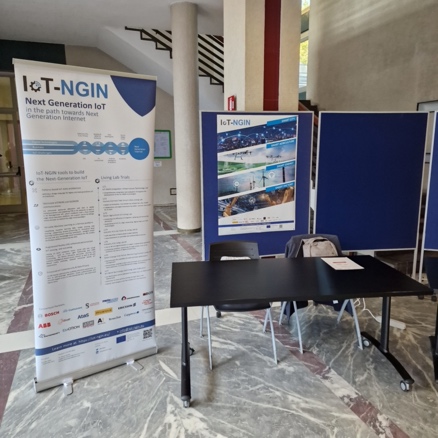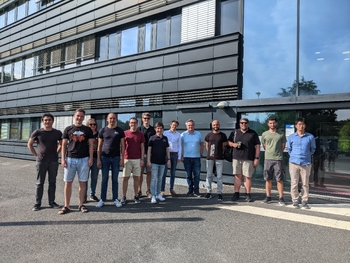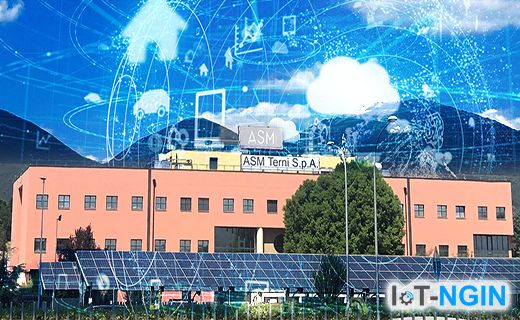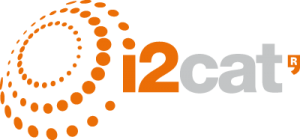
Newsletter Autumn 2023

Dear Readers,
The IoT-NGIN project comes to an end after a remarkable three-year journey. Throughout this period, we have faced and overcome significant challenges, including the COVID-19 pandemic and the ongoing conflict in Ukraine. Despite these challenges, we are proud that our collective efforts have produced amazing results.
Our achievements emphasize the importance of collaboration and knowledge sharing across a range of technical disciplines. The diversity of teams and initiatives we have built, along with our Living Labs and Open Call partners, have helped to make a huge and lasting impact. This collaboration not only highlights the sustainability of the IoT-NGIN project but also demonstrates the power of collaborative innovation.
Our project partners have made significant efforts to implement the various aspects of the project, and they are determined to exploit project results as we move forward. We firmly believe that our work has made a significant technological contribution and has benefited European citizens. This journey has been challenging and rewarding, and we sincerely thank everyone who stayed with us and enjoy reading our newsletters. As we prepare for the final review of the project, we invite you to visit our latest newsletter, which covers the highlights of our journey and accomplishments.
Yours sincerely,
Dr. Ghasan Bhatti (Capgemini)
Project coordinator
Project Outcomes
IoT-NGIN comes to an end, boasting of rich portfolio of next-generation IoT tools, designed, developed, validated and piloted within the project. IoT-NGIN has delivered innovations on the network, communication, security and application side of IoT.
Specifically, IoT-NGIN has developed enhancements on IoT Underlying Technology. These include the IoT-NGIN Device-to-device (D2D) solution for improving 5G coverage in areas not well served by public networks. It is a simple but effective methodology for coverage extension by establishing a D2D communication between the node outside the cell coverage area and a relay inside the coverage area. A metrics exchange is established between the participants to select the most suitable relay for the target performance. This selection process exploits various metrics of interest that can be enriched if necessary. This fits perfectly into the IoT-NGIN context, where one challenge related to deploying 5G in wide area networks is the short network coverage of approximately 500 m depending on the frequencies used and the attenuation of signals in a given location.
In addition, IoT-NGIN has contributed to developing deterministic communications bringing 5G closer to private industrial networks. These include the design of 5G core that supports the latest 3GPP standard specifications including all the necessary network functions (NF) for connecting UE devices to fixed LAN and become native TSN devices. The 5G core developed in IoT-NGIN has been deployed and piloted in ABB factory, Finland. The pilot setup includes the support for Ethernet PDU which is uniquely available currently in CMC 5G Core – in contrast to commercial 5G networks only supporting IP PDU sessions for data exchange between mobile devices and data networks such as public Internet.
Moreover, 5G integration has been enhanced through IoT-NGIN improved 5G APIs, increase the ease of use for application developers and decrease the required knowledge of the underlying infrastructure. The API resources are grouped into three different categories, namely 5G Connectivity and Device Management, Microservice Lifecycle Management and Network Slice Management. IoT-NGIN has also created a Secure Edge Cloud Framework (SECF) for micro-services. The so-called RustyHermit is used to show the applicability and robustness of unikernels, an alternative to containers solution in which the kernel is linked as library to the application and realized as bootable application, resulting in increased security. RustyHermit can support C/C++ and Fortran by providing a cross-compiler to build unikernels on top of a Linux system, allowing application development for the IoT world. The IoT-NGIN SECF caters for the creation of containers standardized, so that other tools like Kubernetes can build upon different varieties of container implementations through own container spawner runh that can spawn common containers but also containers based on a microVM and the unikernel RustyHermit.
In addition, IoT-NGIN provides contributions to enhancing IoT Intelligence. This is achieved through the IoT-NGIN MLaaS (ML-as-as-Service) platform, addressing stream technologies, MLOps, reinforcement learning, storage, blockchain, conversion, monitoring and federated learning. MLaaS supports ML model storage by integrating MinIO, Rook and Ceph; Data storage as PostgreS and InfluxDB; Data acquisition as MQTT, Kafka, Camel-k; IAM/AAI Keycloak and CI/CD installation based on Argo-CD. In addition, modules for online model training, model translation and zero-knowledge model verification based on Blockchains have been added. Concerning the Privacy-Preserving Federated Learning (PPFL) Framework, locally trained ML models are aggregated in a ‘server’ node and shared to the ‘clients’, without disclosing data to each other, while enforcing privacy preservation during model exchange. The PPFL Framework provides easy access to diverse federated learning approaches, able to operate for different applications. In particular the following frameworks are integrated and enhanced: NVIDIA FLARE, FLOWER and Tensorflow Federated. The following table shows the main contributions with respect to the state of the art.
IoT-NGIN enhancements towards IoT Tactile & Contextual Sensing/Actuating refer to IoT Device Discovery and Indexing, IoT Device Access Control and IoT Device Augmented Reality actuation. Concerning IoT Device Discovery and Indexing, fast and versatile software components have been developed for recognition, positioning and indexing of different objects. Different recognition methods, both visual and non-visual, are integrated in the Discovery module and the main advancements concern the reduction of latency in the detections, improvements in the accuracy and the robustness of the methods. The modules recognized in the IoT Discovery are registered in the FIWARE-based IoT Device Indexing Module, with several information per device and the main novelties are the ability of the IoT Device Indexing of integrating big numbers of diverse IoT data sources, providing context-aware querying and supporting historical data services.
The IoT Device Access Control service has been implemented to handle in a flexible way the access to the resources of the Project. The module is implemented as a flexible Ingress gateway enforcing chained access control methods, following different access control mechanisms which are implemented as plugins: Proximity plugin, OpenID Connect Authentication plugin and Self Sovereign Identities plugin.
The IoT Device Augmented Reality actuation is a module able to communicate with different devices, framework and tools. The main novelty is that a set of APIs have been created, that will allow the different AR tools to interact with the IoT Device Indexing module.
Furthermore, IoT-NGIN provides enhancements for IoT cybersecurity and data privacy, following a comprehensive approach towards Federated Learning cybersecurity. This is done by introducing the IoT Vulnerability Crawler (IVC), as well as its dynamic defense mechanism through the Malicious Attack Detector (MAD), also leveraging on advanced ML and Generative Adversarial Networks (GAN) based Data Generator. IVC aims to scan the participating IoT nodes for vulnerabilities and report back its findings. Within the second half of the project, the final version of IVC has been released, integrating 2 plugins, namely OWASP zap and log4shell scanner, which cover a wide range of vulnerabilities (more than 200).
Moreover, the GAN-based Dataset Generator aims for the creation of poisoned datasets that assist addressing attacks against IoT and Federated Learning systems. It features two variants, namely one for generating IDS Network data and one for image datasets. Within the second period, the image generation variant has been implemented and used for introducing poisoning attacks in FL. It has been developed and tested with plant disease datasets and used for testing MAD. Specifically, relevant experiments include deployment of the GAN Generator (images) on a malicious FL node, synthetic images' creation and data poisoning attack realization by flipping images’ labels. MAD has aimed to provide network attacks detection capabilities enabling also the support of online processing on Suricata data; on the other hand, it has been further developed to facilitate the detection of ML poisoning attacks. For the part of the ML poisoning attacks, GAN-based data poisoning attacks, with little deviation on individual nodes’ parameters, which cannot be detected with common techniques proposed in FL.
Regarding MTD Honeypots, the 2nd and final version of the MTD Honeypot framework has been implemented, that incorporates the IP Randomization technique.
Moreover, IoT-NGIN has made significant contribution in terms of data privacy and sovereignty through the Decentralized Interledger Bridge (DIB) component, realizing an optimized implementation supporting a great number of distributed, ledger-independent transactions/sec even in extreme use cases.
In addition, on-device access control solution for constrained devices and the QR code / GS1 Digital Link based discovery for Device Triplets (Semantic Twins, Digital Twins and IoT devices) has been implemented and prototyped. Privacy-preserving SSIs have been developed for the Triplets and SAREF ontologies have been exploited to support Semantic Twins (STs). Moreover, the work on the Semantic Twins (STs) (previously referred to as Meta-Level Digital Twins) has been completed, allowing to solve many typical technical problems faced in developing solutions that utilize Triplets, but also to streamline the related business processes, thus opening up many new business opportunities.
Last, but not least, the pilot activities have been completed during operation in the IoT-NGIN Living Labs (LLs):
- Human-Centred Twin Smart Cities Living Lab, Finland
- Smart Agriculture IoT Living Lab, Greece
- Industry 4.0 Use Cases Living Lab, Spain
- Industry 4.0 Use Cases Living Lab, Finland
- Smart Energy Grid Monitoring / Control Living Lab, Italy
Specifically, the final results and outcomes of the pilot validation processes have been collected for each of the 10 use cases in the context of the defined scenarios. Moreover, the outcomes of the assessment of Quality-of-Experience (QoE) per use case or Living Lab have been presented, as derived by pilot end-user’s feedback to relevant questionnaires, developed specifically for each business case.
Last, but not least, assessment and evaluation of the acquired results has been conducted, verifying the progress towards the initially set Key Performance Indicators (KPIs) for each LL or UC. In addition, deviations from the initial planning, limitations and design optimizations have been identified for each LL, while replication guidelines are provided, allowing reproducibility of the pilot scenarios.
As a conclusion, the LL goals and objectives have been met, with minor or no deviations. The pilot execution and evaluation of the IoT-NGIN tools have been successful in reaching the targets of our KPIs, while the identified limitations provide lessons learnt for applying optimizations and enhancements in IoT-NGIN components and use cases in future research and innovation activities.
We invite stakeholders among the developers’ community, IoT, edge and cloud sector, as well as the project’s application domains to gain insights through our results on the project’s GitLab group and our website.
IoT-NGIN Activities
IEEE Café

Dr. Marios Sophocleous, representing eBOS Technologies Ltd, has showcased IoT-NGIN project and more specifically the Smart Agriculture Living Lab at the 1st IEEE Conference on AgriFood Electronics (CAFE) that was organised at Politechnico di Torino in Torino, Italy on September 25-27th of 2023. This event provided the opportunity to IoT-NGIN’s Smart Agriculture Living Lab to be showcased at a dedicated booth with a roll-up banner and a poster, enhancing IoT-NGIN’s outreach to the scientific community. On the last day of the conference, an Industrial Workshop (IAFE) was organised attracting key player in the field, such as Synopsis and ST Microelectronics, hence further reaching the Industrial community as well.
Unikernel Workshop @ RWTH-Aachen

On the 7th of July, RWTH-Aachen had the pleasure to host a workshop with international guests on Unikernels, one of the technologies being promoted in IoT-NGIN. Presentations were given not only about the developments made in IoT-NGIN, but also about the work done in other projects, which led to fruitful discussions and many inspirations. Many students also attended the workshop, showing their interest in this new and exciting technology. We would like to thank all participants and look forward to the next opportunity to continue this interesting discussion format.
OpenDay @ ASM Terni

On September 15th, ASM Terni S.p.A. opened the doors of its Smart Energy Living Laboratory to around 40 guests, including experts from the electrical, technological, industrial, and computer science sectors, showcasing the innovative Internet of Things (IoT) solutions developed throughout the project's duration. The main topics addressed included aspects of a proactive approach to smart grid monitoring and management, integration of IoT devices in buildings, and interoperability between devices, platforms, and services of the IoT-NGIN project. A key highlight was the introduction of an open-source platform for IoT device communication, focusing on privacy and security. This achievement aligns with the Next Generation Internet initiative's vision of a human-centric Internet. The event concluded with a virtual tour of the ASM Terni living lab, during which the results, services, and use cases within the ASM LIVING LAB in Terni were showcased.
OpenDay @ BOSCH
The "Open Day," organized as part of Task 7.4, provided a dynamic platform for stakeholders, industry professionals, and the interested public to explore advanced technologies developed during the project. BOSCH and I2CAT exhibited innovations in indoor localization methods, which included Ultra-Wideband (UWB), light-based triangulation, and artificial vision technologies. The latter was particularly notable for its ability to calculate object trajectories and issue collision alerts. To showcase the practical applications of these localization technologies, data was visualized through virtual reality using special glasses and multiple display screens. Throughout the day, multiple presentations and live demonstrations were held, giving attendees the opportunity to experience the VR glasses and witness the systems in action. The event received good feedback and offered insights for further development and future deployment of these technologies.
Living Lab Status
As the IoT-NGIN project has been in its final stages, WP7 partners have made substantial progress in the validation process within each Living Lab. Validation, in this context, provides a detailed examination of why specific tests were conducted, which components are used, what requirements are addressed, a description of test setups, and the step-by-step procedures followed. This testing validation documentation is an integral part of deliverable D7.4, providing a clear vision of the validation efforts.
The central focus of the efforts in this phase has been to compile Deliverable D7.4, which serves as a collection of the final results obtained during the development of use cases within different Living Labs. Within this deliverable, partners have taken care to highlight any deviations from the originally planned operations, including trial site descriptions, equipment lists, data collection summaries, and testing scenarios, much of this information was already covered in D7.3. However, in D7.4, partners have ensured that these lists have been reviewed and updated as needed to reflect any changes or refinements that have appeared during the development.
Another important aspect of the final stage is evaluating the user acceptance. To measure user acceptance, WP7 partners have employed Quality of Experience (QoE) assessments. These QoE assessments are in the form of questionnaires, tailored to the unique characteristics and requirements of each Living Lab. These questionnaires are distributed to relevant stakeholders to measure the value and effectiveness of the developed solutions. Furthermore, when applicable, each Living Lab has delivered a Quality of Service (QoS) assessment to provide a detailed description or measurement of the overall performance of the provided services.
Open Calls
We are glad to announce that Open Call (OC) subprojects have successfully completed their mission in IoT-NGIN.
Regarding OC#1, during the remote review meeting, held on the 28th of September 2023, each project had the chance to present the sub-project achievements and relevant deliverables due in the reporting period. Moreover, the sub-project results were demonstrated through demos (either live or recorded), showcasing their integration and validation results.
The IoT-NGIN OC #1 participating projects presented the outcomes of their work in the context of the IoT-NGIN Living Labs. More specifically:
- SmartVIT subproject from Beia Concult International, Romania, developed and validated a system for precision viticulture and meteorology in the context of the project’s Smart Agriculture Living Lab.
- ML Drone subproject from ACCELIGENCE Ltd, Cyprus, collaborated with project’s Smart Agriculture Living Lab where they integrated and validated their UAV-based embedded platform as a compatible framework for deploying and running ML and analytical services.
- CATIE project from CATIE, France, integrated and validated their 6TRON starter kit developed in the project in the project’s Smart Energy Living Lab.
- QuasaR-NGIN subproject from Think Biosolution Ltd, Ireland, integrated and validated their chronic disease prevention & management platform coordinated in the context of the Smart Industry Living Lab in BOSCH.
- EGMOI subproject from Energiot Devices SL - Spain, incorporated their solutions including self-powered IoT device for smart monitoring in the Smart Energy Living Lab.
Also, the OC#2 sub-projects running the GROWTH phase of the cascading funding process have been successfully completed. This last phase of this journey found 3 competent SMEs working on delivering successful demonstration of their products. The three sub-projects qualified for this last phase have been:
- IoT-DRACO by COMSENSUS.
- Private5G by Allbesmart LDA.
- IMPERIAL by Internet Security and Privacy Solutions P.C.
The OC#2 “GROWTH” phase has been completed successfully with the final review, held remotely on September 29, 2023. Out of the three candidates, IoT-DRACO was voted as Top#1 sub-project after a public pitch of the three subprojects to IoT-NGIN consortium, thus winning the additional prize of 5000€.
We are happy to see innovative solutions being derived through these projects, building and extending IoT-NGIN tools. IoT-NGIN congratulates and thanks the involved partners for their work and hopes that developed innovations entail sustainable impact both for the European industry and society!
Spotlight: IoT-NGIN Partners Introduce Themselves
Cumucore

Cumucore Oy is a Finnish company founded in 2015 by two networking entrepreneurs, with a proven track record of successful projects and patents developed in Nokia and several start-ups. They aspire to be a leader in digital transformation through innovative 5G Core solutions. Their vision is to drive the connectivity of the future, enabling industries and communities to harness the full potential of 5G technology. Their mission is to disrupt the industrial sector by providing flexible and affordable mobile connectivity both for big companies and SMEs. The main CMC product is a fully virtualized 3GPP compliant 4G EPC Packet Core and 5G Packet Core, based on containers (containerized). It scales down very well for small networks. Cumucore is optimized for up to 10.000 users or devices and up to 10 base stations. Cumucore can scale up based on geographical distribution of mobile packet cores, providing multi-site connectivity. Their 4G/5G Packet Core is built to scale according to business needs, allowing companies to expand their networks as their user base and requirements grow, while catering to the Industry 4.0 landscape. Additionally, We are pioneering the replacement of traditional Ethernet cables, ushering in a new era of seamless mobile connectivity.
I2CAT

i2CAT is a non-profit technology and innovation centre located in Barcelona (Spain) which promotes R+D+i activities in Internet Technologies within the ICT industry. The centre stands up for a new model in a new conception of innovation: the collaboration between companies, public administration, the academic environment and end-users. Thus, it eases an open innovation framework, characteristic of the Internet culture. The vision of i2CAT is to achieve Internet excellence in research and innovation activities applied to the market needs, and become an international strategic partner driving the deployment of the Internet across the economic, industrial and social sectors. Its board is based on an open innovation collaboration model ranging in all sectors mentioned before. Some board members are: Cisco, Orange, Fujitsu, Juniper, Interoute and Vodafone, plus four Catalan government departments and the three main technical universities of Catalonia, led by Universitat Politècnica de Catalunya (UPC). i2CAT’s activities are concentrated around, but not limited to, novel network services and technologies (fixed and mobile), open access networks, sensor networks, e-health, networked media systems and industrial Internet, with special focus on NFV and SDW/N technologies, new clean slate architectures, Future Internet experimentation, sensor networks, IoT, M2M, with EC footprint in 119 projects (1 FP6, 31 FP7, 44 H2020, 25 HORIZON EUROPE, 3 DEP, 1 CEF, 6 CIP and 9 in other EU areas), being 15 of them coordinated projects.
Within IOT-NGIN, i2CAT has lead the research and development of platform components, capabilities, and tools to enhance Ambient Intelligence and contextual sensing and actuating. i2CAT has deployed techniques for device recognition and enhanced positioning based on promising technologies such as computer vision, UWB and Visual Light Positioning. Also, i2CAT has worked in the implementation of Augmented Reality tools for a better user interaction and has leaded the creation of an open-access repository of IoT-AR resources that can be used by third-party applications to enrich their interaction with IoT sensors and the real-world objects. Also, i2CAT has contributed to the dynamic management of 5G resources in the edge to improve the communications performance. Finally, i2CAT has validated the developments of the project in a real factory setup , within the Industry 4.0 living lab, in cooperation with Bosch.
ABB

ABB is a leader in automation and power technologies that enable utility and industry customers to improve their performance while lowering environmental impact. The ABB Group of companies operates in around 100 countries and employs about 145,000 people. As one of the world’s leading engineering companies, we help our customers to use electrical power efficiently, to increase industrial productivity and to lower environmental impact in a sustainable way. The ABB product portfolio is covered by four business areas: ABB's Electrification business offers a wide-ranging portfolio of products, digital solutions and services, from substation to socket, enabling safe, smart and sustainable electrification. ABB's Motion business is the leading supplier of drives and motors, globally. We provide customers with the complete range of electrical motors, generators, drives and services, as well as integrated digital powertrain solutions. ABB's Process Automation business offers a broad range of solutions for process, hybrid and maritime industries, including industry-specific integrated automation, electrical and digital solutions, control technologies, software and advanced services, as well as measurement & analytics offerings. ABB's Robotics & Discrete Automation business provides value-added solutions in robotics, machine and factory automation. Our integrated automation solutions, our application expertise across a wide scope of industries and our global presence deliver tangible customer value. ABB Drives Oy is part of ABB’s Motion business and is developing, manufacturing and selling variable speed drives and related services. It is a local Finnish entity of global ABB Business Line Drives which is the world largest variable speed drives company.
In IoT-NGIN project, ABB Drives Oy has contributed by developing the industry 4.0 Living Labs. In the first use case, the Human-centered Augmented Reality assisted build-to-order assembly solution have been developed. The target was to improve assembly work at factory by utilizing digital models of frequency converters and to develop AR solutions to offer solutions to improve i.e. assembly work, maintenance work and trainings for different operators. In the second use case, ABB has built and developed condition monitoring system for powertrains at laboratory. Furthermore, advanced analytics of powertrain based on data collected have been created and demonstrated. Semantic Twin approach solutions developed within IoT-NGIN has been implemented in powertrain condition monitoring system at ABB laboratory. In the third use case, ABB Drives Oy has developed and investigated TSN solutions using 5G private network infrastructure at laboratory. This has been done in close co-operation with IoT-NGIN partner Cumucore.
Copyright © IoT-NGIN 2021. All rights reserved.

This project has received funding from the European Union's Horizon 2020 research and innovation programme under Grant Agreement No 957246
Contact us: info@iot-ngin.eu
IoT-NGIN respects your privacy. Review our online Privacy Policy

